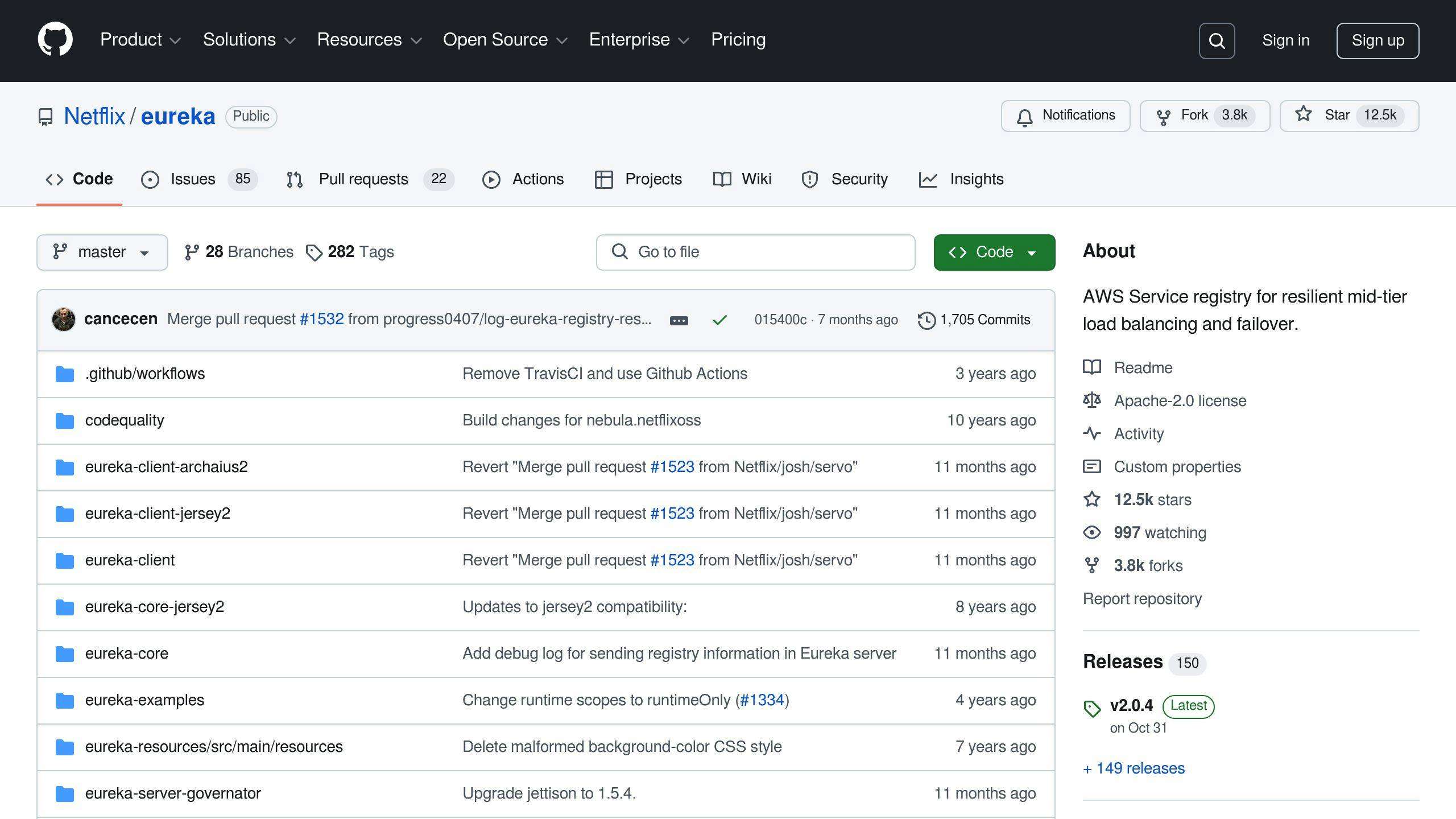Microservices are a modern way to build scalable, independent systems, and tools like Spring Boot and Docker make it easier than ever to create them. Here’s what this guide covers:
- Why Microservices?: Independent scaling, easier updates, and autonomous team workflows.
- Spring Boot: Simplifies microservice development with pre-configured tools.
- Docker: Packages applications into isolated, portable containers.
- Key Steps:
- Set up Spring Boot projects with essential dependencies like Spring Web and Spring Data JPA.
- Use Eureka for service discovery and Spring Cloud Gateway for routing.
- Containerize services with Docker and manage them with Docker Compose.
- Deploy and scale efficiently using tools like Kubernetes.
- Monitoring: Track performance with tools like Prometheus and Grafana.
This tutorial provides a step-by-step guide to building, deploying, and managing microservices for both development and production environments.
Spring Boot Microservices Project Example – Dockerize the application

Setting Up a Spring Boot Project
Now that you’ve grasped the basics of microservices and the tools involved, it’s time to set up a Spring Boot project to serve as the backbone for your microservices.
Starting a Spring Boot Project
Spring Boot makes building microservices easier, thanks to tools like Spring Initializr. Head over to Spring Initializr, configure your project (e.g., choose Maven or Gradle, set the Java version), and add dependencies like Spring Web and Spring Data JPA. Once done, generate and download your project files [1].
Must-Have Dependencies for Microservices
Here are some essential dependencies to include in your project:
| Dependency | Purpose |
|---|---|
| Spring Web | Create RESTful APIs with HTTP endpoints and controllers |
| Spring Data JPA | Handle database operations and manage entity relationships |
| Lombok | Simplify your codebase by reducing boilerplate with annotations |
| Spring Cloud | Add features like service discovery and load balancing |
These dependencies streamline development by covering key aspects of microservice functionality.
Structuring Your Project
A well-organized project structure makes your code easier to manage and scale. Spring Boot encourages a layered approach with clear separation between components like controllers, services, and repositories. Configuration files are typically stored in the src/main/resources directory [2].
The main application class, marked with the @SpringBootApplication annotation, serves as the starting point for your microservice:
@SpringBootApplication
public class Application {
public static void main(String[] args) {
SpringApplication.run(Application.class, args);
}
}
To maintain clarity, follow these conventions when structuring your project:
- Controllers: Handle HTTP requests and define API endpoints.
- Services: Contain the business logic of your application.
- Repositories: Manage database interactions.
- Models: Represent your application’s data structures.
With your Spring Boot project set up and organized, you’re ready to start developing and deploying microservices, focusing next on their architecture and communication strategies.
Designing and Deploying Microservices
Let’s take your project setup to the next level by implementing core microservices patterns with Spring Boot to create a system that’s both functional and scalable.
Microservices Architecture Basics
Spring Boot makes it easier to build microservices by offering tools for service isolation, RESTful communication, and service-specific configurations. Here’s how its features align with key architectural needs:
| Aspect | Spring Boot Feature | Description |
|---|---|---|
| Service Isolation | Spring Boot Application | Allows independent deployment |
| Data Management | Spring Data JPA | Handles service-specific data |
| Communication | REST Controllers | Manages inter-service interactions |
| Configuration | application.properties/yaml | Stores settings for each service |
Setting Up Service Discovery with Eureka

Service discovery is crucial for enabling dynamic communication between microservices. With Eureka Server, you can achieve this by including the spring-cloud-starter-netflix-eureka-server dependency and annotating your main class like this:
@SpringBootApplication
@EnableEurekaServer
public class EurekaServerApplication {
public static void main(String[] args) {
SpringApplication.run(EurekaServerApplication.class, args);
}
}
This setup ensures that services can locate each other dynamically without hardcoding endpoints.
Using an API Gateway for Microservices
Spring Cloud Gateway acts as a central entry point for client requests, handling tasks like routing, security, and load balancing. You can define routes in application.yml to manage traffic efficiently:
spring:
cloud:
gateway:
routes:
- id: user-service
uri: lb://user-service
predicates:
- Path=/api/users/**
In this configuration, any request to /api/users/** is routed to the user service. The lb:// prefix enables load balancing, ensuring reliability and scalability. This approach is inspired by Netflix’s architecture, which supports over 500 microservices using tools like Eureka Server and containerization [2].
sbb-itb-f454395
Containerizing Microservices with Docker

Once your microservices are designed and running locally, the next step is to package them for consistent and scalable deployment using containers.
What Is Docker?
Docker is a tool that packages applications into isolated environments called containers. These containers are lightweight, fast to start, and include everything needed to run an application – like code, runtime, libraries, and settings. For microservices, Docker ensures each service operates in its own environment, eliminating conflicts and simplifying deployment.
| Container Component | Purpose | Example |
|---|---|---|
| Base Image | Provides OS and runtime | openjdk:8-jdk-alpine |
| Application Code | Your compiled application | myapp.jar |
| Dependencies | Required libraries and tools | Spring Boot dependencies |
| Configuration | Environment-specific settings | application.properties |
Creating Docker Images for Spring Boot
To package your Spring Boot application, create a Dockerfile:
FROM openjdk:8-jdk-alpine # Base image with Java runtime
WORKDIR /app # Set working directory
ARG JAR_FILE=target/myapp.jar # Define JAR file location
COPY ${JAR_FILE} app.jar # Add compiled application
EXPOSE 8080 # Declare port
ENTRYPOINT ["java", "-jar", "/app/app.jar"] # Start command
Build the Docker image by running:
docker build -t myapp:1.0 .
Tip: Optimize your builds to exclude unnecessary files and tools, which can reduce image size significantly.
Managing Containers with Docker Compose
Docker Compose simplifies running multiple containers by enabling services to connect easily, using container names instead of IPs. Here’s an example configuration:
version: '3'
services:
eureka-server:
build: ./eureka-server
ports:
- "8761:8761"
# Optional: Add health checks for better reliability
user-service:
build: ./user-service
ports:
- "8080:8080"
depends_on:
- eureka-server
environment:
SPRING_PROFILES_ACTIVE: docker
EUREKA_CLIENT_SERVICEURL_DEFAULTZONE: http://eureka-server:8761/eureka/
You can replicate similar configurations for other services, adjusting ports and environment variables as needed.
Start all services with:
docker-compose up -d
To manage and troubleshoot containers, use commands like:
docker statsto monitor resource usagedocker logs <service>to check logsdocker psto list running containers
Once your microservices are containerized, the next challenge is deploying and managing them effectively in production environments.
Deploying and Managing Microservices
After containerizing your microservices, selecting the right deployment strategy and monitoring tools is key to keeping your production environment running smoothly.
Deployment Methods for Microservices
Your deployment method will depend on the size and needs of your application. For smaller apps or development environments, you can use a simple Docker Compose setup, as mentioned earlier. In production, you’ll need to enhance this configuration with features like replicas and health checks:
services:
user-service:
deploy:
replicas: 2
healthcheck:
test: ["CMD", "curl", "-f", "http://localhost:8080/health"]
interval: 30s
timeout: 10s
retries: 3
For large-scale production, Kubernetes is the go-to solution. It automates scaling, deployment, and container management. The 2022 CNCF Kubernetes Adoption Survey highlights Kubernetes as the industry standard for container orchestration [2].
| Deployment Method | Best For | Key Features |
|---|---|---|
| Docker Compose | Development, Small Apps | Easy setup, Quick deployment |
| Kubernetes | Production, Large Scale | Horizontal scaling, Rolling updates, Recovery |
| Hybrid Approach | Medium Scale | Combines benefits, Allows gradual scaling |
If your application needs to scale quickly, Kubernetes offers the automation and flexibility required to handle changing demands, aligning well with microservices architecture.
"Containerization is a key enabler of microservices architecture, providing isolation, portability, and scalability." – Adrian Cockcroft, former Netflix Architect [1]
This is especially important in production settings, where tools like Kubernetes support advanced deployment techniques.
Monitoring and Logging Tools
Once your microservices are deployed, monitoring their performance and health becomes essential. Tools like Prometheus, paired with Grafana, help track metrics such as response times and resource usage. For centralized logging and troubleshooting, the ELK stack (Elasticsearch, Logstash, Kibana) is a reliable choice [3].
You can set up Spring Boot applications to log data efficiently:
logging.file.name=/var/log/myapp.log
logging.pattern.file=%d{yyyy-MM-dd HH:mm:ss} [%thread] %-5level %logger{36} - %msg%n
Netflix provides a great example of how monitoring tools can ensure system stability. They use Prometheus and Grafana for proactive issue detection and maintain high availability across thousands of microservices. Their setup also includes Eureka for service discovery and a mix of Docker and Kubernetes for container management.
Key Metrics to Monitor:
- Response times and latency
- Error rates and types
- Resource usage (CPU, memory)
- Health of service dependencies
- Transaction throughput
With strong deployment strategies and monitoring tools, your microservices will be well-equipped to handle demanding production environments.
Conclusion
Key Takeaways
This tutorial covered the main steps for building scalable microservices using Spring Boot and Docker. A survey by Red Hat revealed that 71% of organizations now use containerization, with Docker as the leading choice. This highlights the growing importance of understanding both containerization and microservices.
Here’s a quick breakdown of the process:
| Phase | Key Tools and Components |
|---|---|
| Development & Containerization | Spring Boot, Eureka, Docker |
| Production | Monitoring (Prometheus), Logging (Grafana) |
By mastering these phases, you can smoothly transition microservices from development to production.
Additional Learning Resources
To expand your knowledge of microservices and containerization, check out these resources:
- Spring Boot Documentation: A detailed guide to the framework.
- Docker Tutorials: Official guides to containerization.
- KodNest Full Stack Development Courses: Practical training for developers.
- Udemy Microservices Architecture Programs: Specialized courses for deeper understanding.
- Coursera Container Orchestration Courses: Focused on orchestration tools and techniques.
Hands-on practice is key – start with official guides, then move into specialized courses to refine your skills. Stay curious and keep experimenting with the latest tools and techniques to stay ahead in this rapidly evolving field.





